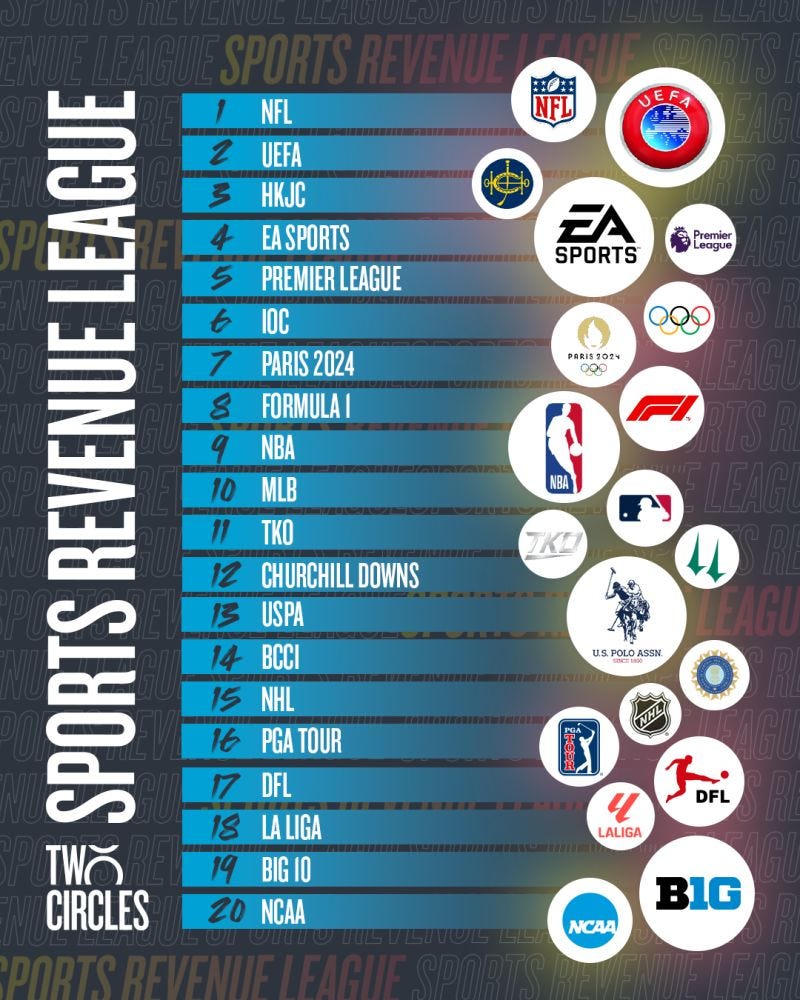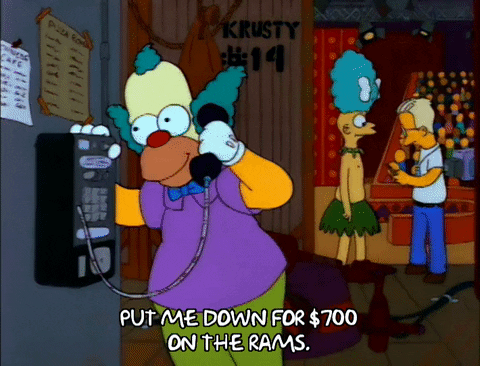'Big get bigger' shock; Sport IP's 71 Billion Dollar Question; Harold Macmillan and lumpy revenue; Obviousness; Capturing betting money; Forgotten tribes; Inside Edge, Wedge Issues and Expected Goals
Overthinking the sports business, for money
The 71 Billion Dollar Questions About Sports IP Revenue
Two Circles have done a league table of sports IP revenue. And it’s worth your time.
UP Coming - I talked with Gareth Balch at length about it, and you can listen in tomorrow, usual channels. The research has been meticulously done and you will be quoting from it regularly. This is a top 20, but it’s much longer than that.
(Random and off-topic aside: I was a teacher when they brought in school league tables and - spoiler - we were against them. (Teachers are usually against everything, and they don't go on strike in August). But we were right. Our worry was misleading simplification. We understood and supported the need to hold up schools to parent scrutiny, capturing good and bad practice, empowering better decisions etc. The problem is the map doesn’t reflect the territory. Today, the endlessly complex, messy and brilliant reality of a whole school is pared down to a single word. It’s infantile, misleading and the system has been gamed. What gets measured etc, and our kids are over tested and unhappy. End of aside.)
Obviousness vs Interesting anomalies
As with all league tables, I looked first at the top and the bottom, and then went in search of oddities and anomalies, those that seemingly over or under perform expectations.
As you’d expect, sport’s big acronyms are high on the list.
Boring but important: One thing to note is how the list methodology over-rewards the centre. This is done to prevent double counting, by capturing the moment the media and sponsor money first enters the sports economy.
So, it’s the NFL not the Dallas Cowboys, the Premier League not Man United; F1 not Ferrari; IPL not Mumbai Indians etc etc etc. There’s a whole PhD in the relative contributions to overall value of individual team and athlete brands. Super Leagues have been started on this question.
The big get bigger : in the last decade, the % value share of the Top 20 Sports IP Owners of total revenue has grown from 35% to 44%
Market concentration:
The Top 25 make 50% of the revenue
Top 100 make 70% of revenue
65% of the Top 20 grew revenue faster than the market last year
100% of the Top 20 Sports IP Owners grew revenue faster than the market in the last decade
Sport remains a B2B business : 70% of the Top 20's revenues come from sponsorship and media vs 66% of the rest of the Top 500
FIFA’s lumpy cycles and the Harold Macmillan Rule
FIFA is not in the top 20, because of the Harold Macmillan Rule: Events, dear boy, events.
There was no men’s World Cup in the year of measurement. Paris 2024 and the IOC are both in the top ten for the opposite reason.
UEFA are up there every year, FIFA are on it only every now and then. As McKinsey might put it: This must get on Infantino’s tits.
And the inconsistency of revenue flow explains, in part at least, the very existence of this summer’s 2025 FIFA/MAGA Club World Cup.
The massive domestic NBA TV deal doesn't show up in these accounts, so there's a few place changes to be expected when/if Two Circles do this again next year.
But this is all health and safety. Dig a layer down and you get to some nuggets.
The Unofficial Sports Revenue League Table - aka the leaky bucket analogy
There’s a whole other ocean of money that’s missing from Two Circles’ map of the world (we discuss it in detail on the podcast).
And this is where we get to the useful anomalies.
Take for example, the Hong Kong Jockey Club at number 3, which turns over more than the IOC, F1, the Premier League and the NBA.
But we never talk about it, probably because it’s about betting.
HKJC’s ‘historical and unique integrated business model’ means that a big slug of the betting money is captured and flows back in the form of tax or charitable donations (HKJC is a non-profit…).
Betting, like illegal streaming, is money that doesn’t get recognised in the formal sports economy.
One of the strategic questions for every sport CEO is, what are you? And what do you want to be? At a more pedestrian level, are you an events business, a media business or, how far do you go to try and capture the money that leaks via corporate hospitality or retail (US Polo Association generated $2.4B in retail and licensing revenue last year), that could be plugged by in-house offerings.
The big leaks are betting and illegal streaming.
Then we get to an ethical question, which is should, because as soon as you do that, are you encouraging it or are you taking the money and taxing it properly, for the redistribution into the sports economy. Again, a PhD there. But also, it gets to the existential question, as the media market changes, and as we're told, and have been told for many years, that the broadcasters don't want to carry on playing this game in the same way as they have. What do you do?
I'll reference George Pyne at this point.
Pyne is one of the most successful private equity investors in sport, via Bruin Capital. Note how high betting is in his analysis of TGL, golf’s newest sport entertainment product.
Another catalyst for TGL’s success and expansion is the league’s relative bet-friendliness, enabled by removing some of the variability and latency that has limited golf wagering:
- High-Frequency Data Capture: TGL’s advanced ball tracking means every shot is measurable (ball speed, launch angle, spin rate, distance, etc.) and fed directly into broadcast and digital platforms, enabling granular in-play betting markets (e.g., “Will the next shot hit the green?”).
- Faster Pace of Play: TGL matches are timed and formatted to last ~2 hours, half the length of a typical PGA TOUR round. This pace creates more frequent intervals that are prime for hashtag#microbetting, where users can wager on short-term outcomes such as who will win the next hole, whether the ball will travel more than 200 yards, and whether the match will go to overtime.
With scalable tech, a best-in-class broadcast partner, and low overheads, TGL’s model is built for the modern sports economy—and women’s golf could be the next piece of the puzzle.
I often say on the podcast that betting is so much higher in private equity's framing of the sport valuation question than is commonly acknowledged.
What are the lessons from the Hong Kong Jockey Club? Is it a historical anomaly or are bits of it copyable? How have they've done it, what are the implications, and how would you go about doing something similar in, for example, football?
How much money is spent on football betting that never touches the football economy, never ever reaches clubs or the players, never flows through the pyramid, never pays for anything useful. That’s a massive number that just goes to betting company shareholders. It’s a parasite.
But what would plugging that leak really mean, by recognising it and taxing it properly. Currently the relationship is monetised by sponsorship and other bits of inventory. It all feels like a sideshow.
The Squeezed Middle
Most of us don’t live in the top 10. We live in the squeezed middle.
Which is why we made a podcast series of that name.
UP alumni and PTI CEO Ben Wells has written about it, and it’s a nice comparison to the talk of the top 20 global giants:
Those rights-holders in the Squeezed Middle projected revenue growth of 3% for the next year and only 20% believed their sponsorship business will deliver “major” growth in the forthcoming five-year period.
The problem is that The Squeezed Middle are selling analogue in a digital world.
Category exclusivity – one of the founding “rules” of sports sponsorship – is one area that actually prevents rights-holders ability to grow sponsorship revenue. It made sense in the pre-internet era when the vast majority of sponsorship rights and activation were above the line. But in 2025, it just represents inefficiency.
Brand marketing spend has shifted digital, with nearly two-thirds of global ad spend going to just three companies – Amazon, Google and Meta.
Forgotten tribes
Maggie Murphy makes a good point here.
In 2017-18, only 50% of WSL clubs were Premier League clubs. This season 100% of WSL clubs were Premier League backed. Yet, next season will see the first independent club – London City Lionesses – make its WSL debut, after a truly thrilling close to the Women’s Championship last weekend.
For many years only teams that genuinely cared about women’s football, such as Yeovil, Doncaster Belles or Notts County gave blood, sweat and tears - for no cash - to create the foundations for what we see today. Many fell by the wayside or slipped down the tiers as women’s football’s potential (and investment gap) started to be uncovered. Licence applications to play in the top tiers of English football from those clubs that had strong histories and heritages were rejected in favour of the bigger men’s clubs that were encouraged and willing to stump up what was for them, then, limited amounts of cash. Now those bigger men’s clubs are themselves finding it hard to keep up with and justify increasing costs - few having prioritised investments into the commercial/revenue driving sides of the business to provide stability or autonomy to the women’s team.
I’m a bit obsessed about forgotten team brands.
This extends more generally to what gets lost when sport is pushed through the money and marketing industry lens, and you end up with a winner takes all framing beloved of the tech industry.
What if, sport doesn't fit that model?
How many of the names on the Two Circles list of sports IP are there due to great executive decision making, and how many are there just because they were lucky - right place, right time and all that.
Listen to Expected Goals
If only there was somewhere you could and have a grown up conversation about the business of women’s football?
Hold that thought:











Those remarks on TGL and betting give the impression of someone who didn’t watch “the product”!